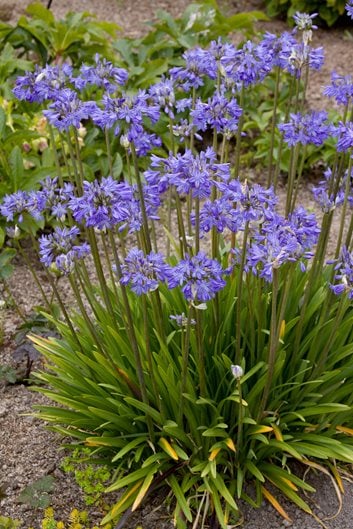Common Agapanthus Issues and Just How to Solve Them
Common Agapanthus Issues and Just How to Solve Them
Blog Article
Unleashing the Secret to Effective Agapanthus Growing: Idea for a Flourishing Yard
In the realm of horticulture, cultivating agapanthus efficiently calls for a calculated method that encompasses various aspects of plant care. With careful focus to information, one can open the secrets to supporting these spectacular blossoms, causing a garden that grows with beauty and vibrancy. By recognizing the nuances of agapanthus cultivation, one can produce an environment where these plants flourish and grow abundantly. In the complying with discussion, we will discover important pointers and techniques that will guide you in the direction of a thriving agapanthus garden, offering understandings right into best methods, soil problems, watering methods, and much more.
Growing Agapanthus: Finest Practices
When growing Agapanthus, proper soil prep work is important for ensuring effective development and development of these gorgeous flowers. Agapanthus, frequently referred to as Lily of the Nile or African lily, grows in well-draining dirt with a somewhat acidic to neutral pH degree - Agapanthus. Prior to growing, it is critical to modify hefty clay dirts with raw material such as garden compost or peat moss to improve drain and give essential nutrients for the plants
To plant Agapanthus, choose a place that gets full sunlight to partial shade, as this will certainly advertise healthy and balanced growth and abundant flowering. Dig a hole twice the size of the plant's root sphere and put the Agapanthus at the very same depth it was previously expanding. Gently backfill the hole with dirt, weighing down strongly to get rid of any air pockets around the roots.
Water the newly planted Agapanthus extensively and remain to keep the soil uniformly wet, especially throughout the plant's energetic expanding season. Agapanthus. Applying a balanced plant food once a month can better support the plant's development and flowering. By following these ideal techniques for growing Agapanthus, you can create a sensational display of these captivating flowers in your garden
Suitable Dirt Issues for Agapanthus
For ideal growth and flowering success of Agapanthus plants, guaranteeing the soil problems are suitable is vital. Agapanthus thrives in well-draining dirt with a slightly acidic to neutral pH level ranging from 6.0 to 7.0. This type of dirt permits for appropriate water drainage, avoiding waterlogging which can result in root rot. To boost dirt drainage, take into consideration adding natural matter such as compost or peat moss when preparing the planting website. Moreover, Agapanthus favors soil that is rich in nutrients, so including a balanced plant food throughout the growing period can advertise healthy development and vivid blooms.

Watering and Feeding Tips
To make certain healthy and balanced development and vivid flowers, appropriate watering and feeding methods are crucial for effective Agapanthus farming. Agapanthus plants benefit from regular watering, especially throughout the expanding season. It is suggested to water deeply when a week, making sure the dirt is damp but not saturated. Throughout heat or in pots, even more regular watering may be necessary to avoid the dirt from drying out entirely.
When it involves feeding Agapanthus, a well balanced plant food with equal components nitrogen, phosphorus, and potassium can be used in the spring to promote healthy and balanced growth and blooming. Slow-release plant foods are optimal for giving nutrients progressively over a prolonged period. Avoid over-fertilizing, as this can bring about extreme vegetation growth at the expense of flowers.
Furthermore, incorporating natural matter like compost right into the soil can boost nutrient levels and enhance soil framework, aiding in the general health of the Agapanthus plants. By adhering to these watering and fertilizing ideas, garden enthusiasts can guarantee their Agapanthus plants prosper and generate stunning screens of flowers.
Trimming and Deadheading Techniques
Appropriate trimming and deadheading methods play a crucial role in keeping the health and visual appeals of Agapanthus plants, enhancing the important methods of watering and feeding for effective cultivation. Pruning Agapanthus entails eliminating invested flower heads, yellowing or dead fallen leaves, and general shaping of the plant to advertise much better development. Deadheading, the procedure of getting rid of discolored flowers, not just boosts the plant's appearance however also urges further flowering.
When deadheading Agapanthus, it is suggested to snip off the flower stem at the base utilizing sharp, clean shears. This process redirects the plant's energy from seed production back into navigate to this site origin and vegetation growth, promoting a healthier and a lot more durable plant. Regular deadheading can expand the growing duration of Agapanthus and protect against self-seeding, which can result in overcrowding.
In terms of pruning, Agapanthus normally gain from a light trim after blossoming to clean up the plant and motivate fresh development. Reducing the spent blossom stems and getting rid of any kind of broken or dead foliage helps maintain the plant's vitality and total look. However, it is necessary to prevent reducing into the crown of the plant, as this can damage its wellness.

Protecting Agapanthus From Pests and Diseases
Applying efficient parasite and disease administration strategies is critical to protecting the wellness and vitality of Agapanthus plants in cultivation. One usual bug that influences Agapanthus is the Agapanthus borer, a caterpillar that tunnels into the plant, creating damage to the leaves and blossoms.
In enhancement to insects, Agapanthus are at risk to diseases such as root rot and fungal leaf spots. By remaining cautious and addressing pest and illness issues immediately, gardeners can help their Agapanthus flourish and flourish.

Verdict
To conclude, successful cultivation of agapanthus needs appropriate planting techniques, suitable soil problems, adequate watering and feeding, routine pruning and deadheading, and protection from insects and diseases. By following these tricks and ideas, gardeners can ensure a flourishing yard loaded with lovely agapanthus flowers. Agapanthus. Keep in mind Your Domain Name to maintain consistent treatment and attention to detail to advertise the health and wellness and longevity of these magnificent plants
When planting Agapanthus, correct soil prep work is essential for making sure effective growth and advancement of these beautiful blossoms.Water the freshly planted Agapanthus completely he said and proceed to keep the dirt uniformly moist, specifically throughout the plant's energetic growing season.For ideal development and growing success of Agapanthus plants, ensuring the soil conditions are perfect is crucial. When hair transplanting or growing Agapanthus, make sure the dirt is well-prepared to supply the required structure for the plants to develop themselves successfully. One usual insect that influences Agapanthus is the Agapanthus borer, a caterpillar that passages into the plant, creating damages to the fallen leaves and blossoms.
Report this page